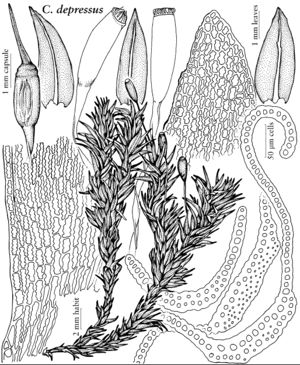Codriophorus depressus
in R. Ochyra et al., Cens. Cat. Polish Mosses, 140. 2003,.
Plants large and rigid, forming extensive patches or loosely caespitose, olive or yellowish green, olivaceous, olive, golden, or rufous brown to blackish green distally, brown to blackish brown proximally, sometimes dark blackish green to black throughout. Stems (2–)4–10(–13) cm long, tough. Leaves oblong- or ovate-lanceolate to broadly ovate, (2.1–)3–4.5(–5) × (0.8–)1–1.3(–1.5) mm; margins 1- or 2-stratose distally in several rows of cells, entire or sometimes sinuate or with a few blunt, irregular teeth at the apex; apices acute or obtuse; costa subpercurrent, (80–)100–200 µm wide at the base; laminal cells 1-stratose throughout or entirely to partially 2-stratose in the distal part, smooth or very slightly papillose on young leaves. Inner perichaetial leaves yellowish hyaline throughout. Seta brown, 4.5–7 mm. Capsule brown to reddish brown, symmetric or slightly curved and gibbous, obloid to cylindric, 1.8–3 mm, peristome teeth, lanceolate, 350–500 µm high, reddish or yellowish brown, finely papillose to nearly smooth basally, densely low-papillose distally, deeply 2-fid or tripartite down for two thirds of their length. Spores (10–)12–15(–17) µm.
Habitat: Semi-aquatic on grantic rocks or soil
Elevation: moderate to high elevations (1300-2800 m)
Distribution

Calif., Nev., Oreg.
Discussion
Codriophorus depressus is a semi-aquatic saxicole growing directly attached to or on soil over granite boulders, walls, stones and slabs along the banks of intermittent flowing watercourses or in stream beds. It is often submerged in swiftly flowing water in the rapids of intermittent streams or in cascading streamlets, or on dripping rocks and seeps over exposed granite rock terraces during snowmelt that then become dry by mid-summer. It is most often found in shaded or diffusely lit sites, rarely in open, permanently or seasonally dry habitats, throughout subalpine mixed coniferous forests, and it is restricted in its distribution to California except for a single record in the border area of adjacent Nevada at Lake Tahoe and southern Oregon (Jackson). The species is primarily characterized by the costa that is exceptionally broad, strongly flattened and weakly convex on the abaxial side, and U-shaped adaxially in the distal part, the leaves that are broadly concave to broadly canaliculate, as well as laminal cells that are smooth or only very slightly papillose. Codriophorus depressus is superficially similar to C. acicularis and C. norrisii, but the leaves in those two species are broadly lingulate, acute to broadly rounded, and usually distinctly dentate or erose-dentate at the apex, and the costa is generally narrower and crescent-shaped on the abaxial side. Particularly reliable for distinguishing C. acicularis and C. norrisii are the prominently papillose laminal cells, which sharply contrast with the smooth or only finely roughened cells in C. depressus. Moreover, C. norrisii has distinctly limbate leaves almost all around, and the innermost perichaetial leaves are chlorophyllous in the distal third. Codriophorus depressus is more likely to be confused with Bucklandiella pacifica, which, however, has smaller leaves, less than 3 × 1 mm, and its costae are narrower, less than 120 µm, distinctly narrowly canaliculate distally and lying at the bottom of a deep and narrow-angled groove, partly enclosed in the basal part. Moreover, B. pacifica is a lowland species, whereas C. depressus is a montane moss.
Selected References
None.
